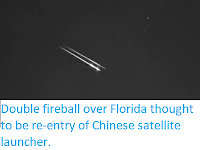Witnesses in the Australian state of Victoria reported
seeing a
fireball meteor on the evening of Friday 22 May 2020. A
fireball
is defined
as a meteor
(shooting star) brighter than the
planet Venus. These are typically caused by pieces of rock burning up in
the atmosphere, although on this occasion the Astronomical Society of Victoria believe it was caused by part of a Russian Space Launcher re-entering the atmosphere, noting the low angle and apparent speed of the object, which were inconsistent with an extra-terrestrial object. The fireball is thought to have been caused by one of the late stages of a Soyuz-2-1b rocket launched from the Plesetsk Cosmodrome at about 5.30 pm Victoria time.
Fireball 'meteor' thought to have been caused by the re-entry of part of a Russian Space Launcher over Victoria, Australia, on Friday 22 May 2020. Paul Campbell/Twitter.
Extra-terrestrial objects large enough to cause a visible fireball enter the Earth's atmosphere several times a
year, though unless they do so over populated areas they are unlikely to
be noticed. They are officially described as fireballs if they produce a
light brighter than the planet Venus. The brightness of a meteor is caused by friction with
the Earth's atmosphere, which is typically far greater than that caused
by simple falling, due to the initial trajectory of the object. Such
objects typically eventually explode in an airburst called by the
friction, causing them to vanish as an luminous object. However this is
not the end of the story as such explosions result in the production of a
number of smaller objects, which fall to the ground under the influence
of gravity (which does not cause the luminescence associated with
friction-induced heating).
The launch of a Russian Soyuz-2-1b rocket from the Plesetsk Cosmodrome on 22 May 2020. The fireball seen over Victoria, Australia, is thought to have been caused by one of the rocket stages from this launch re-entering the atmosphere. Roscosmos.
These 'dark objects' do not continue along the path
of the original bolide, but neither do they fall directly to the ground,
but rather follow a course determined by the atmospheric currents
(winds) through which the objects pass. Scientists are able to calculate potential trajectories for hypothetical dark
objects derived from meteors using data from weather monitoring services.
See also...
Follow Sciency Thoughts on Facebook.








